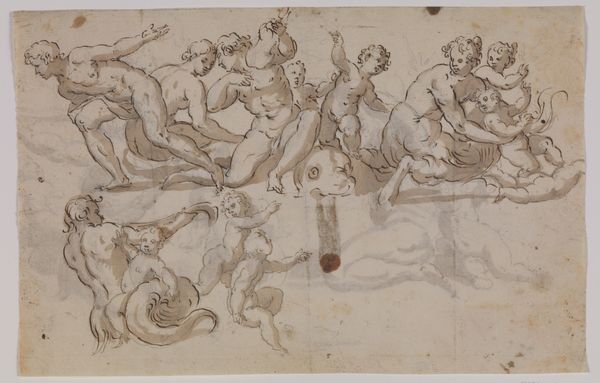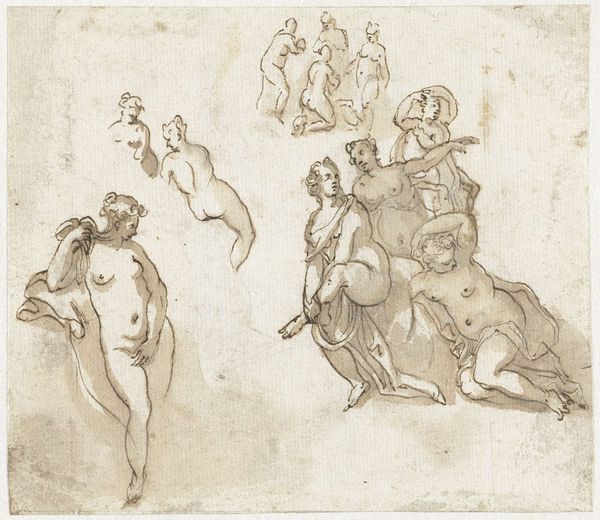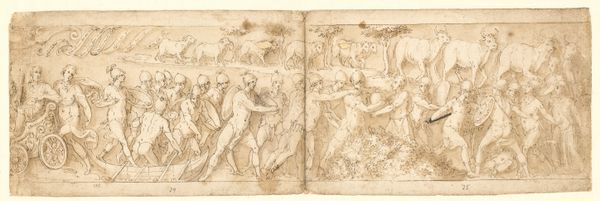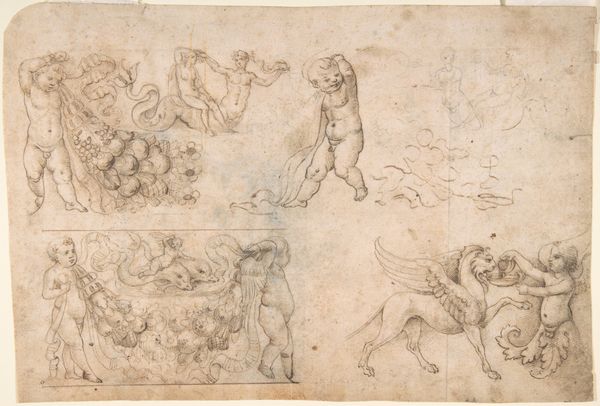
Roman soldiers crossing a river in boats (largely restoration; XXXIV)2; a fighting Roman soldier (from the end of XXIV); Roman guards bringing barbarian prisoners before the emperor (omitted in the drawing; end of XXV); beginning of a march (beginning of XXVI) 1544 - 1618
0:00
0:00
drawing, paper, ink
#
drawing
#
figuration
#
paper
#
11_renaissance
#
ink
#
history-painting
#
italian-renaissance
#
watercolor
Dimensions: 133 mm (height) x 432 mm (width) (bladmaal)
Curator: I see chaos. What's this, a storyboard for a Roman epic? Editor: Not quite. This is a drawing by Giovanni Guerra, active between 1544 and 1618. The full, rather descriptive title, is "Roman soldiers crossing a river in boats... and so on." It's rendered in ink on paper and belongs to the Statens Museum for Kunst collection. Curator: Right. You know, I find myself drawn to how the figures are layered and arranged. It is really chaotic at first glance but eventually resolves to convey the march. Do you feel the restoration muddies that? Editor: I wouldn't say muddled. In fact, the restorations actually highlight Guerra’s intention of conveying constant movement, which is quite masterful, if I may say so myself. Notice how he overlaps figures and utilizes the limited tonal range to simulate depth. There’s an interesting contrast in texture, as well; those figures wading through the water compared with the ones riding, almost suspended, on horses. Curator: It's got that swirling energy, doesn't it? As though caught in a dance, a dangerous ballet of war, you almost sense the weight. I think it reminds me of history paintings but done, instead, with sketches, a snapshot of history. But without that usual pomp that can kill you inside... Editor: Indeed. History painting often served to aggrandize or teach moral lessons, but here, there's a raw immediacy to the moment, even fragmented into scenes. We are witnesses of its making. The lack of rigid order almost allows the scene to unfold. The eye isn't dictated to go anywhere specific, it almost gives you the power to decide where you land, even for a moment. Curator: It makes you think about all those unsung soldiers, all the movement behind an emperor’s supposed “greatness”, the anonymous faces and figures... There's a quiet rebellion against the monumental. Almost a humanisation through pure, stark action...I feel connected to that Editor: I concur. This isn't about glory; it's about the churning, almost inhuman, labor behind it. A dance, but performed by many, with unknown rewards and heavy cost, a story whispered in ink rather than shouted from the rooftops. Curator: Something quite profound, wouldn't you agree? Editor: Definitely, a reminder of history’s unseen gears, I dare say.
Comments
No comments
Be the first to comment and join the conversation on the ultimate creative platform.













